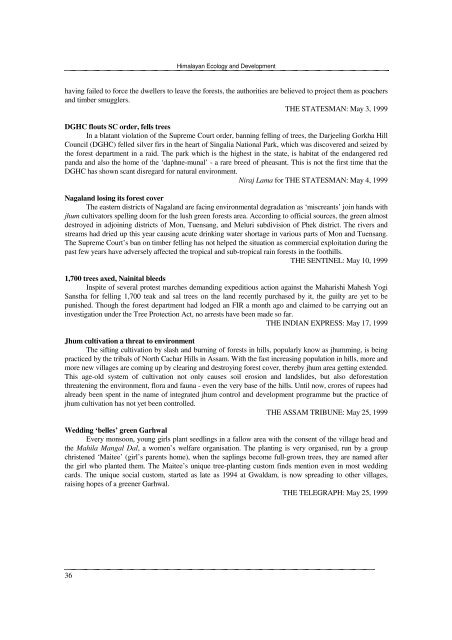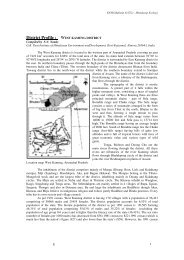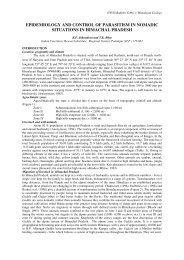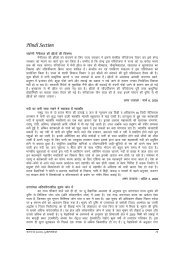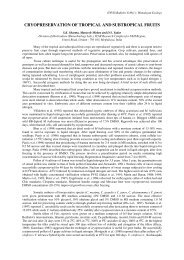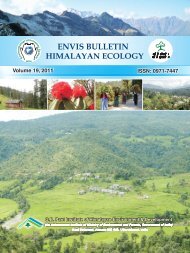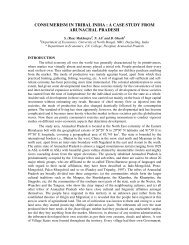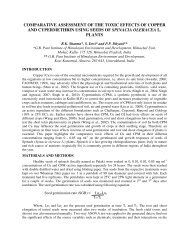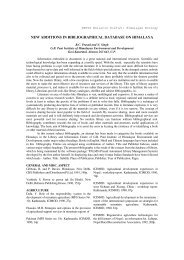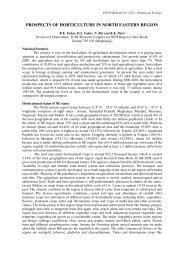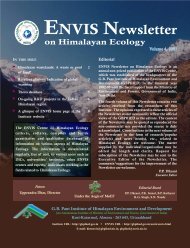Complete PDF - ENVIS Centre on Himalayan Ecology
Complete PDF - ENVIS Centre on Himalayan Ecology
Complete PDF - ENVIS Centre on Himalayan Ecology
Create successful ePaper yourself
Turn your PDF publications into a flip-book with our unique Google optimized e-Paper software.
<strong>Himalayan</strong> <strong>Ecology</strong> and Development<br />
having failed to force the dwellers to leave the forests, the authorities are believed to project them as poachers<br />
and timber smugglers.<br />
THE STATESMAN: May 3, 1999<br />
DGHC flouts SC order, fells trees<br />
In a blatant violati<strong>on</strong> of the Supreme Court order, banning felling of trees, the Darjeeling Gorkha Hill<br />
Council (DGHC) felled silver firs in the heart of Singalia Nati<strong>on</strong>al Park, which was discovered and seized by<br />
the forest department in a raid. The park which is the highest in the state, is habitat of the endangered red<br />
panda and also the home of the ‘daphne-munal’ - a rare breed of pheasant. This is not the first time that the<br />
DGHC has shown scant disregard for natural envir<strong>on</strong>ment.<br />
Niraj Lama for THE STATESMAN: May 4, 1999<br />
Nagaland losing its forest cover<br />
The eastern districts of Nagaland are facing envir<strong>on</strong>mental degradati<strong>on</strong> as ‘miscreants’ join hands with<br />
jhum cultivators spelling doom for the lush green forests area. According to official sources, the green almost<br />
destroyed in adjoining districts of M<strong>on</strong>, Tuensang, and Meluri subdivisi<strong>on</strong> of Phek district. The rivers and<br />
streams had dried up this year causing acute drinking water shortage in various parts of M<strong>on</strong> and Tuensang.<br />
The Supreme Court’s ban <strong>on</strong> timber felling has not helped the situati<strong>on</strong> as commercial exploitati<strong>on</strong> during the<br />
past few years have adversely affected the tropical and sub-tropical rain forests in the foothills.<br />
THE SENTINEL: May 10, 1999<br />
1,700 trees axed, Nainital bleeds<br />
Inspite of several protest marches demanding expeditious acti<strong>on</strong> against the Maharishi Mahesh Yogi<br />
Sanstha for felling 1,700 teak and sal trees <strong>on</strong> the land recently purchased by it, the guilty are yet to be<br />
punished. Though the forest department had lodged an FIR a m<strong>on</strong>th ago and claimed to be carrying out an<br />
investigati<strong>on</strong> under the Tree Protecti<strong>on</strong> Act, no arrests have been made so far.<br />
THE INDIAN EXPRESS: May 17, 1999<br />
Jhum cultivati<strong>on</strong> a threat to envir<strong>on</strong>ment<br />
The sifting cultivati<strong>on</strong> by slash and burning of forests in hills, popularly know as jhumming, is being<br />
practiced by the tribals of North Cachar Hills in Assam. With the fast increasing populati<strong>on</strong> in hills, more and<br />
more new villages are coming up by clearing and destroying forest cover, thereby jhum area getting extended.<br />
This age-old system of cultivati<strong>on</strong> not <strong>on</strong>ly causes soil erosi<strong>on</strong> and landslides, but also deforestati<strong>on</strong><br />
threatening the envir<strong>on</strong>ment, flora and fauna - even the very base of the hills. Until now, crores of rupees had<br />
already been spent in the name of integrated jhum c<strong>on</strong>trol and development programme but the practice of<br />
jhum cultivati<strong>on</strong> has not yet been c<strong>on</strong>trolled.<br />
THE ASSAM TRIBUNE: May 25, 1999<br />
Wedding ‘belles’ green Garhwal<br />
Every m<strong>on</strong>so<strong>on</strong>, young girls plant seedlings in a fallow area with the c<strong>on</strong>sent of the village head and<br />
the Mahila Mangal Dal, a women’s welfare organisati<strong>on</strong>. The planting is very organised, run by a group<br />
christened ‘Maitee’ (girl’s parents home), when the saplings become full-grown trees, they are named after<br />
the girl who planted them. The Maitee’s unique tree-planting custom finds menti<strong>on</strong> even in most wedding<br />
cards. The unique social custom, started as late as 1994 at Gwaldam, is now spreading to other villages,<br />
raising hopes of a greener Garhwal.<br />
THE TELEGRAPH: May 25, 1999<br />
36


